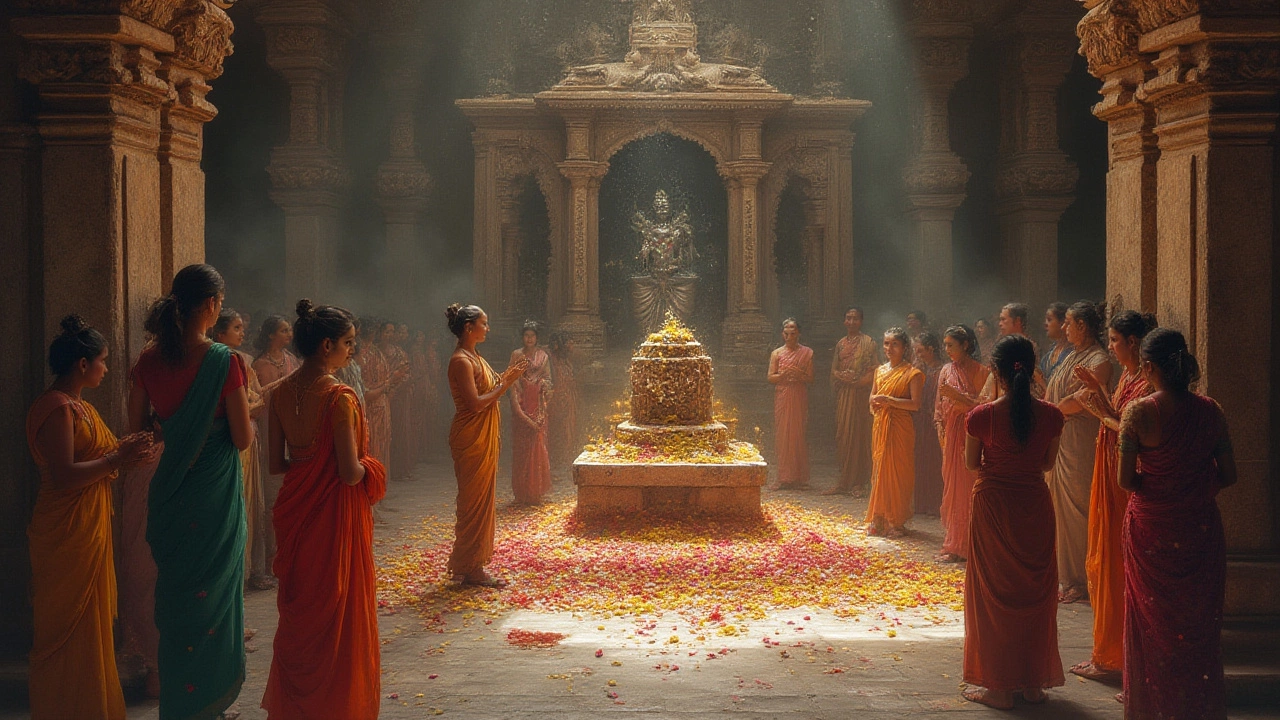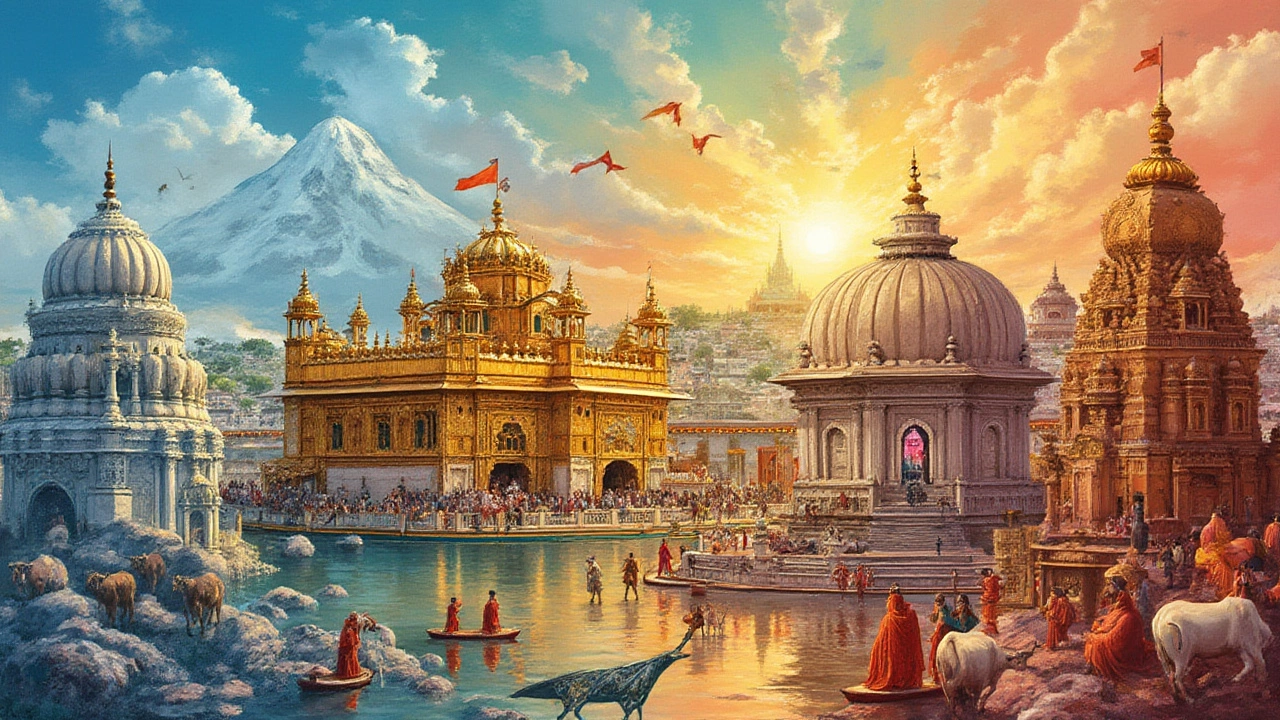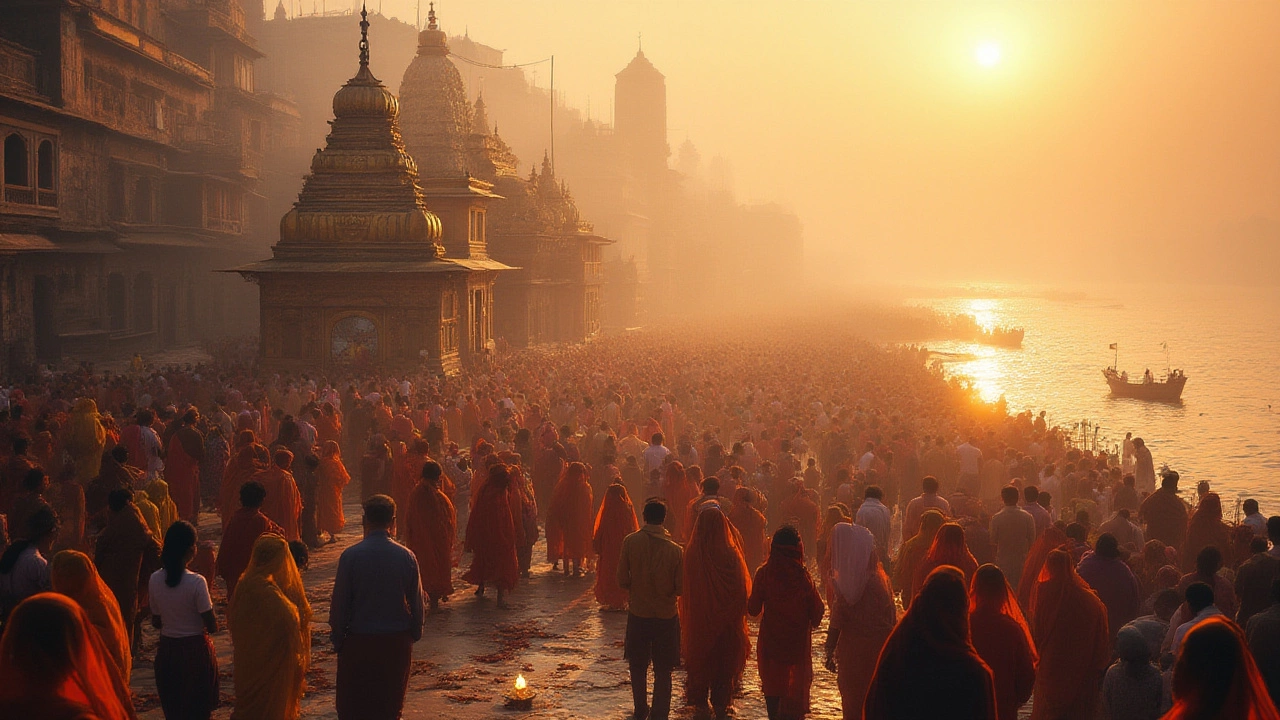People get fierce about the question: which is the holiest temple in India? Every faith here guards its own answer, and every pilgrim on the road has a story to back it up. Some point to the Golden Temple, others claim Kashi Vishwanath, and a few will get misty-eyed about Tirupati or Badrinath. But if you’re hoping for an easy answer, good luck—the debate stretches from dusty ancient myths to 2025’s Insta feeds. Even my cat Felix would probably pick whichever one had the comfiest spot in the sun.
The Concept of Holiness in Indian Temples
What makes a temple “the holiest” anyway? It’s not about being the oldest or the biggest or having the flashiest gold. In India, holiness soaks into a place for all kinds of reasons—mythology, miracles, centuries of prayer, and the sheer pull of faith. Most Hindus will mention Kashi Vishwanath in Varanasi, believed to sit on the world’s axis (“navel of the earth,” as old Sanskrit texts call it). For Sikhs, the Golden Temple (Sri Harmandir Sahib) in Amritsar is the soul of their spirituality—open to all, glowing at night over its sacred lake, serving free food to thousands daily. And then there’s Tirumala’s Sri Venkateswara Temple, whose wealth and crowd-pulling power even outdo some Bollywood blockbusters.
You could climb into debates about which holy city—Varanasi, Amritsar, or Rameswaram—outshines the others, but the real magic is how each temple reflects living faith. There’s more than one way a place gets its reputation. Varanasi is woven into the oldest tales of Shiva, while Amritsar was founded by Sikh Gurus themselves. Miracles, too, leave a mark—like the “Akshaya Patra” (endless pot of food) legend in Tirupati, or the healing step-well at Dwarka.
And then there’s the crowd factor. On special festival days, temples like Tirupati or Vaishno Devi draw numbers that rival entire small cities. According to the Tirumala Tirupati Devasthanams, the temple sees 50,000 visitors on a quiet day and up to half a million on big holidays. That’s faith in action—and logistics on an Olympic scale. Want some numbers? Check out the table below for a quick comparison of India’s most visited temples:
| Temple | Location | Estimated Annual Visitors |
|---|---|---|
| Tirumala Venkateswara | Andhra Pradesh | 30–40 million |
| Golden Temple | Punjab | 6–10 million |
| Kashi Vishwanath | Uttar Pradesh | 5–7 million |
| Vaishno Devi | Jammu & Kashmir | 8–9 million |
| Jagannath Puri | Odisha | 2–3 million |
So, while each temple is the holiest for its faithful, the idea of “holiest” stretches across a spectrum. Not just numbers, but meaning runs deep in every carved idol and echoing chant.
The Golden Temple: Heart of Sikh Faith
If there’s one structure that embodies the Sikh ethos of equality, service, and devotion, it’s the Golden Temple—Sri Harmandir Sahib in Amritsar. You catch your breath the first time its gold-plated gopura shimmers on the Amrit Sarovar lake at sunrise. Designed to welcome all, it has four entrances, literally symbolizing openness. By tradition, Sikhism rejects priestly hierarchies, and here, anyone can eat, pray, and serve in the world’s largest free kitchen, or langar—no questions about religion, caste, or wallet size.
The temple’s history packs drama worthy of epic movies. In the late 16th century, Guru Arjan—the fifth Sikh Guru—designed the site and placed the Adi Granth (their holy book) at the center. Later, invaders tried to wipe the structure out, but it kept rising, its gold topping added by Maharaja Ranjit Singh in the early 1800s. Through British Raj, turbulent 1947 Partition, and Operation Blue Star in 1984, the Golden Temple stood as a beacon of resilience and compassion.
What’s daily life like here? Pilgrims take a cleansing dip in the lake, walk barefoot around the marble path, and bow low at the Guru Granth Sahib. The langar never stops. Meanwhile, musicians play kirtan (devotional songs), often so haunting you’ll find both tourists and regulars sitting in silent awe.
Insider tip: early morning (before sunrise) is something special. You see volunteers—men, women, and kids— scrubbing the floors, and the first light hits the gold. If you’re visiting, bring a scarf or borrow one at the entrance to cover your head. You can join in serving food, too—no one will ask your name, just hand you a ladle and welcome you in. Don’t bring cigarettes or alcohol—it’s strictly prohibited out of respect.
And if you got my cat Felix’s take, he’d probably hang around the langar kitchen, hoping for leftovers, but that’s another story. The point is: it’s not just the optics or the history, it’s the open-door feeling that makes the Golden Temple a spiritual home to millions.

Kashi Vishwanath: The Light of Varanasi
Varanasi has a pulse like nowhere else—holy men chanting, cremation ghats smoking by the river, and in the heart of this living city: Kashi Vishwanath Temple, dedicated to Shiva. Kashi (another name for the city) means “The Luminous One,” and for Hindus, this temple is where heaven and earth touch. Shiva is believed to appear here in a pillar of light—the legendary jyotirlinga. Even the ancient Mahabharata and Skanda Purana mention this patch of ground as the universe’s sacred center.
The original structure was demolished and rebuilt several times—most famously by Mughal emperor Aurangzeb, who replaced it with a mosque. The current temple, rebuilt by Queen Ahilyabai Holkar in 1780, stands just beside the mosque, a symbol of endurance and peaceful coexistence. Even today, you’ll see both devotees lined up for the darshan (sighting of the idol) and curious travelers treading the narrow lanes—a mix of chaos, devotion, and relentless color.
So what hooks people here? First, many Hindus believe a pilgrimage to Kashi Vishwanath and a dip in the Ganges washes away all sins. Death in Varanasi is thought to grant instant moksha—liberation from rebirth. The temple resonates most on festival days—like Shivaratri and Diwali—when lights, flowers, and holy chants spark an atmosphere you just have to stand in to believe.
If you plan a visit: avoid carrying leather items (out of respect), and don’t expect to waltz right in—the queues can run for hours, especially in peak season. Early morning or late evening is less crowded and feels magical, with bells and conch shells echoing off the old stones. Few sights rival watching the sunrise over the Ganga, followed by darshan here.
And a fun fact for the detail nerds: in 2021, the Kashi Vishwanath Corridor Project opened, making access smoother and the area around the temple way less claustrophobic. If long lines deter you, book an early-bird slot or tag along with an official tour.
Tirumala, Vaishno Devi, and Competing Sacred Sites
If you ask around in Andhra Pradesh, “Which is India’s holiest temple?” you’ll get one answer: Tirumala’s Sri Venkateswara Temple. Not just rich (those legendary gold hair offerings and mountains of coins), but also religiously electric. Even Bollywood stars and business tycoons line up for darshan with the rest of us. Known as the “Seven Hills Temple,” the climb itself is part of the pilgrimage—devotees walk hundreds of steps barefoot, heads shaved to offer hair to the deity, as a sign of thanks or hope. Annual visitor numbers are mind-boggling, rivaling Disneyland.
Not far behind, in the piercing peaks of Jammu, is Vaishno Devi. Unlike most temples, you can’t drive right up—pilgrims trek almost 13 kilometers on foot, singing chanting, and sharing food on the way. It’s one of those experiences where the hardship becomes part of the faith, and the air itself seems to buzz with energy. The shrine is linked with miraculous cures and legends of the Mother Goddess outwitting demons—a favorite for families and young people.
Other sacred sites bloom across the country. Jagannath Puri in Odisha? You’ll hear about its wild Rath Yatra chariot festival, drawing in seas of humanity. Madurai’s Meenakshi Temple? It’s iconic for Dravidian architecture and intricate sculptures—people say you can taste the devotion in its spiced prasadam (temple food).
Here are a few quick travel tip nuggets if you’re planning one of these pilgrimages:
- Tirupati: Book your slot well ahead online—walk-in tickets go in minutes during festival season. Carry valid ID, and no electronics inside.
- Vaishno Devi: Pack light, wear layers, and keep cash handy (but not too obvious). Opt for a morning trek to avoid daytime crowds and heat.
- Jagannath Puri: Dress modestly and keep shoes outside. The Rath Yatra festival is worth braving the crowds for, but hotels fill up fast—plan months ahead.
Curiously, many of these temples don’t just work as religious centers; they’re economic powerhouses and social hubs, feeding, employing, and caring for vast communities. You’ll find tech-driven queue systems in places like Tirupati and Varanasi, and special accessibility help for the elderly at most sites.
Felix the cat would probably never make it up Tirumala’s stairs, but even a stubborn pet can’t beat the energy that surges through these spots, day after day.

The Holiest Temple: More than One Answer
So, can we really say there’s a single holiest temple in India? Some Hindus look to Kashi Vishwanath as the “spiritual capital” because of its mention in ancient texts and eternal flame of rituals. Sikhs bow to the Golden Temple, drawn by both history and a philosophy that welcomes every soul, no matter their background. South India—never to be left behind—swears by Tirupati, whose queues are legendary, and whose annadanam (feeding of pilgrims) is just as grand as its gold gifts.
Even a stray cat (maybe Felix’s distant cousin) can wander between these pillars and find food, music, and peace. And every year, people of every shape, size, and faith join the lines, not just to pray, but to soak up a sense of unity and something bigger than themselves.
If you want facts, Kashi Vishwanath, Golden Temple, and Tirumala are neck-and-neck in most “holiest” lists. Each represents an idea of holiness—timelessness, service, or devotion. If statistics sway you, Tirumala has edge-crushing crowds and donations; if you crave beauty and openness, it’s hard to beat the Golden Temple by night. For old soul seekers, Kashi’s spiritual hum is unmatched. Each has its moment, its miracle stories, its chance to leave pilgrims speechless.
Want to dive deeper? Think about catching the major festivals: Diwali in Varanasi, Vaisakhi at Golden Temple, Brahmotsavam in Tirupati. Or get off the main track and visit at dawn, when cleaning crews (and the odd temple dog) make everything ready for the first prayers.
Still want a one-word answer? You’ll find locals in each city who will swear on their ancestors that their temple is the heart of holiness. But nothing matches seeing each one for yourself—and keeping an open mind for the next twist in the story. As long as people seek, serve, and wonder, India will keep its crown as the land of living temples, each holiest in its own right.
